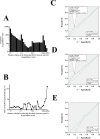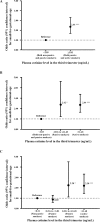Association between maternal passive smoking and increased risk of delivering small-for-gestational-age infants at full-term using plasma cotinine levels from The Hokkaido Study: a prospective birth cohort
- PMID: 30782875
- PMCID: PMC6368030
- DOI: 10.1136/bmjopen-2018-023200
Association between maternal passive smoking and increased risk of delivering small-for-gestational-age infants at full-term using plasma cotinine levels from The Hokkaido Study: a prospective birth cohort
Abstract
Objectives: To investigate the association between plasma cotinine level measured at the 8th gestational month and the delivery of small-for-gestational-age (SGA) infants, using a highly sensitive ELISA method.
Design: Prospective birth cohort study from The Hokkaido Study on Environment and Children's Health.
Setting: Hokkaido, Japan.
Participants: Our sample included 15 198 mother-infant pairs enrolled in 2003-2012.
Main outcome measures: SGA, defined as a gestational age-specific weight Z-score below -2.
Results: The number of SGA infants was 192 (1.3%). The cotinine cut-off level that differentiated SGA infants from other infants was 3.03 ng/mL for both the total population and the full-term births subgroup (sensitivity 0.307; positive predictive value 2.3%). Compared with infants of mothers with a plasma cotinine level of <3.03 ng/mL, infants of mothers with a plasma cotinine level of ≥3.03 ng/mL showed an increased OR for SGA in the total population and the full-term infant group (2.02(95% CI 1.45 to 2.83) and 2.44(95% CI 1.73 to 3.44), respectively).
Conclusion: A plasma cotinine level of ≥3.03 ng/mL, which included both passive and active smokers, was associated with an increased risk of SGA. This finding is of important relevance when educating pregnant women about avoiding prenatal passive and active smoking due to the adverse effects on their infants, even those born at full-term.
Keywords: epidemiology; preventive medicine; public health; reproductive medicine.
© Author(s) (or their employer(s)) 2019. Re-use permitted under CC BY-NC. No commercial re-use. See rights and permissions. Published by BMJ.
Conflict of interest statement
Competing interests: None declared.
Figures



Similar articles
-
Comparison of secondhand smoke exposure measures during pregnancy in the development of a clinical prediction model for small-for-gestational-age among non-smoking Chinese pregnant women.Tob Control. 2015 Oct;24(e3):e179-87. doi: 10.1136/tobaccocontrol-2014-051569. Epub 2014 Jul 21. Tob Control. 2015. PMID: 25052864
-
[Use of prenatal health care and risk of infants born small-for-gestational-age. Preliminary results of a case-control study in the Lódź voivodeship].Przegl Epidemiol. 2004;58(3):537-46. Przegl Epidemiol. 2004. PMID: 15730018 Polish.
-
Prenatal tobacco exposure and ADHD symptoms at pre-school age: the Hokkaido Study on Environment and Children's Health.Environ Health Prev Med. 2019 Dec 7;24(1):74. doi: 10.1186/s12199-019-0834-4. Environ Health Prev Med. 2019. PMID: 31812162 Free PMC article.
-
Determination of nicotine and cotinine in meconium from Greek neonates and correlation with birth weight and gestational age at birth.Chemosphere. 2015 Jan;119:1200-1207. doi: 10.1016/j.chemosphere.2014.09.094. Epub 2014 Nov 1. Chemosphere. 2015. PMID: 25460762
-
High Maternal Circulating Cotinine During Pregnancy is Associated With Persistently Shorter Stature From Birth to Five Years in an Asian Cohort.Nicotine Tob Res. 2019 Jul 17;21(8):1103-1112. doi: 10.1093/ntr/nty148. Nicotine Tob Res. 2019. PMID: 30032178 Free PMC article.
Cited by
-
Ventilatory response to added dead space in infants exposed to second-hand smoke in pregnancy.Eur J Pediatr. 2023 Jul;182(7):3301-3306. doi: 10.1007/s00431-023-04991-5. Epub 2023 May 11. Eur J Pediatr. 2023. PMID: 37166537 Free PMC article.
-
Hokkaido birth cohort study on environment and children's health: cohort profile 2021.Environ Health Prev Med. 2021 May 22;26(1):59. doi: 10.1186/s12199-021-00980-y. Environ Health Prev Med. 2021. PMID: 34022817 Free PMC article.
-
Urinary cotinine cut-off concentrations in children under 5 years for assessing environmental tobacco smoke exposure: a systematic review and meta-analysis protocol.BMJ Open. 2025 May 15;15(5):e094077. doi: 10.1136/bmjopen-2024-094077. BMJ Open. 2025. PMID: 40379337 Free PMC article.
-
Assessing tobacco smoke exposure in pregnancy from self-report, urinary cotinine and NNAL: a validation study using the New Hampshire Birth Cohort Study.BMJ Open. 2022 Feb 7;12(2):e054535. doi: 10.1136/bmjopen-2021-054535. BMJ Open. 2022. PMID: 35131829 Free PMC article.
-
Prenatal exposure to tobacco and adverse birth outcomes: effect modification by folate intake during pregnancy.Matern Health Neonatol Perinatol. 2022 Sep 12;8(1):6. doi: 10.1186/s40748-022-00141-1. Matern Health Neonatol Perinatol. 2022. PMID: 36096906 Free PMC article.
References
Publication types
MeSH terms
Substances
LinkOut - more resources
Full Text Sources
Medical
